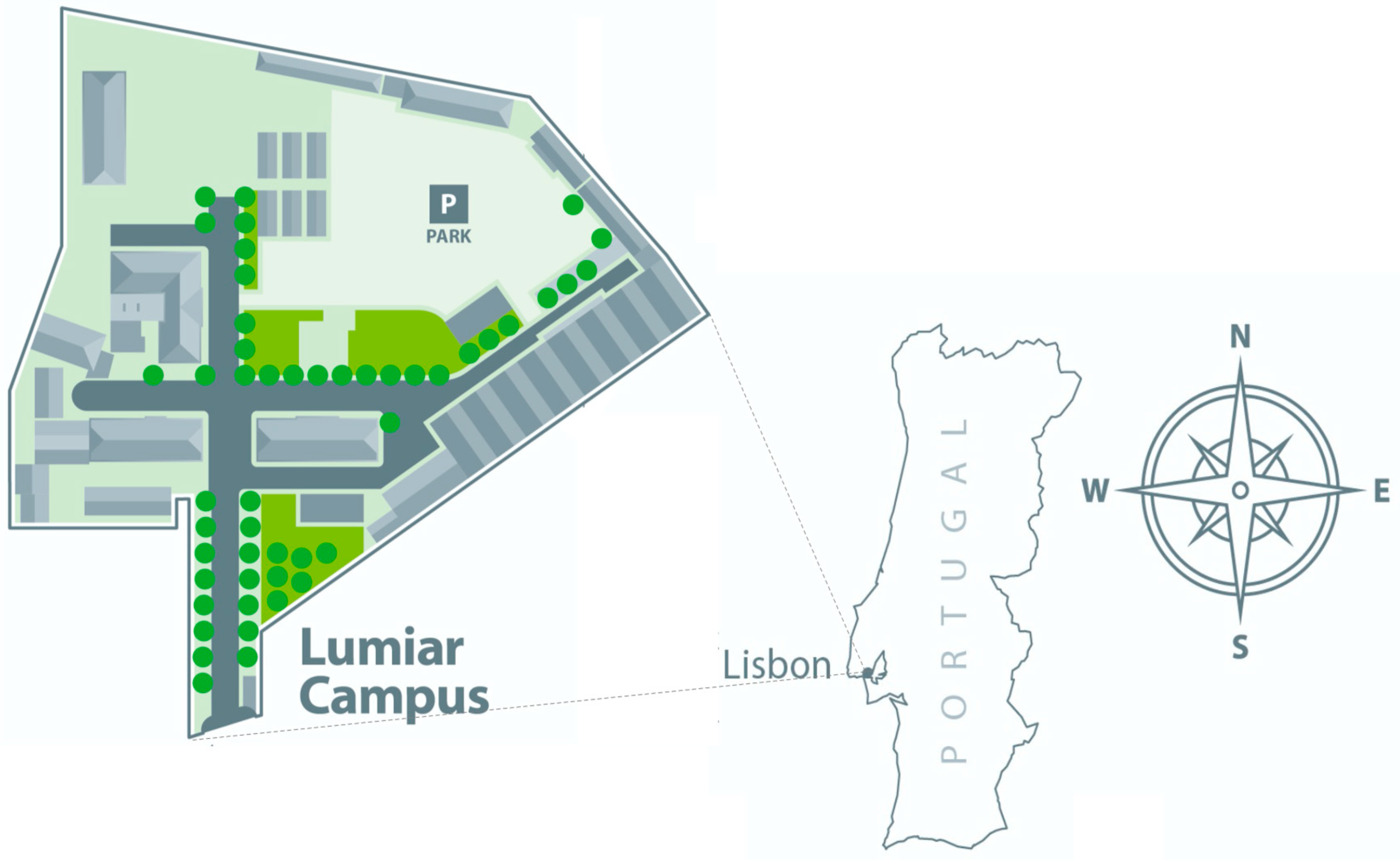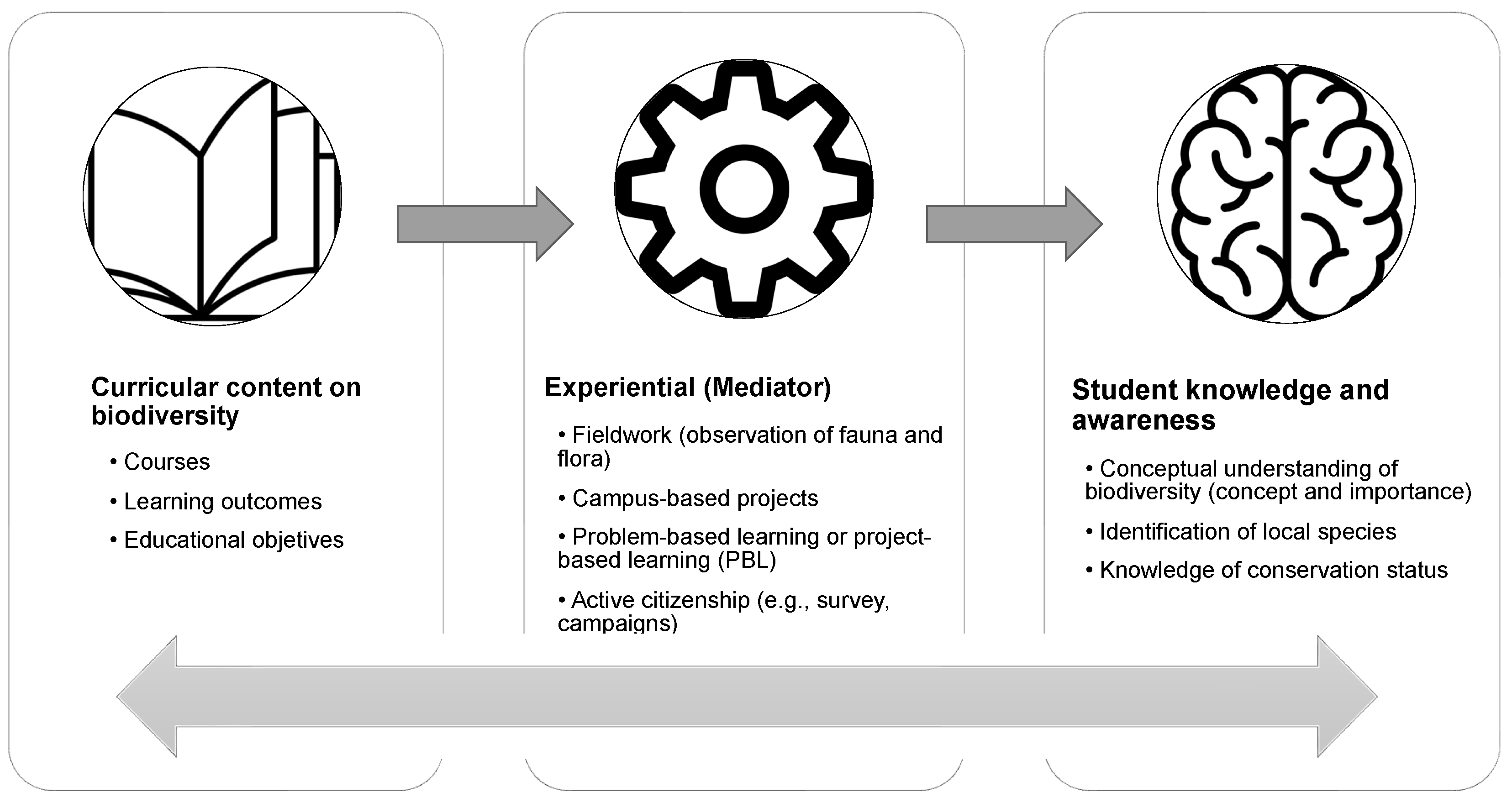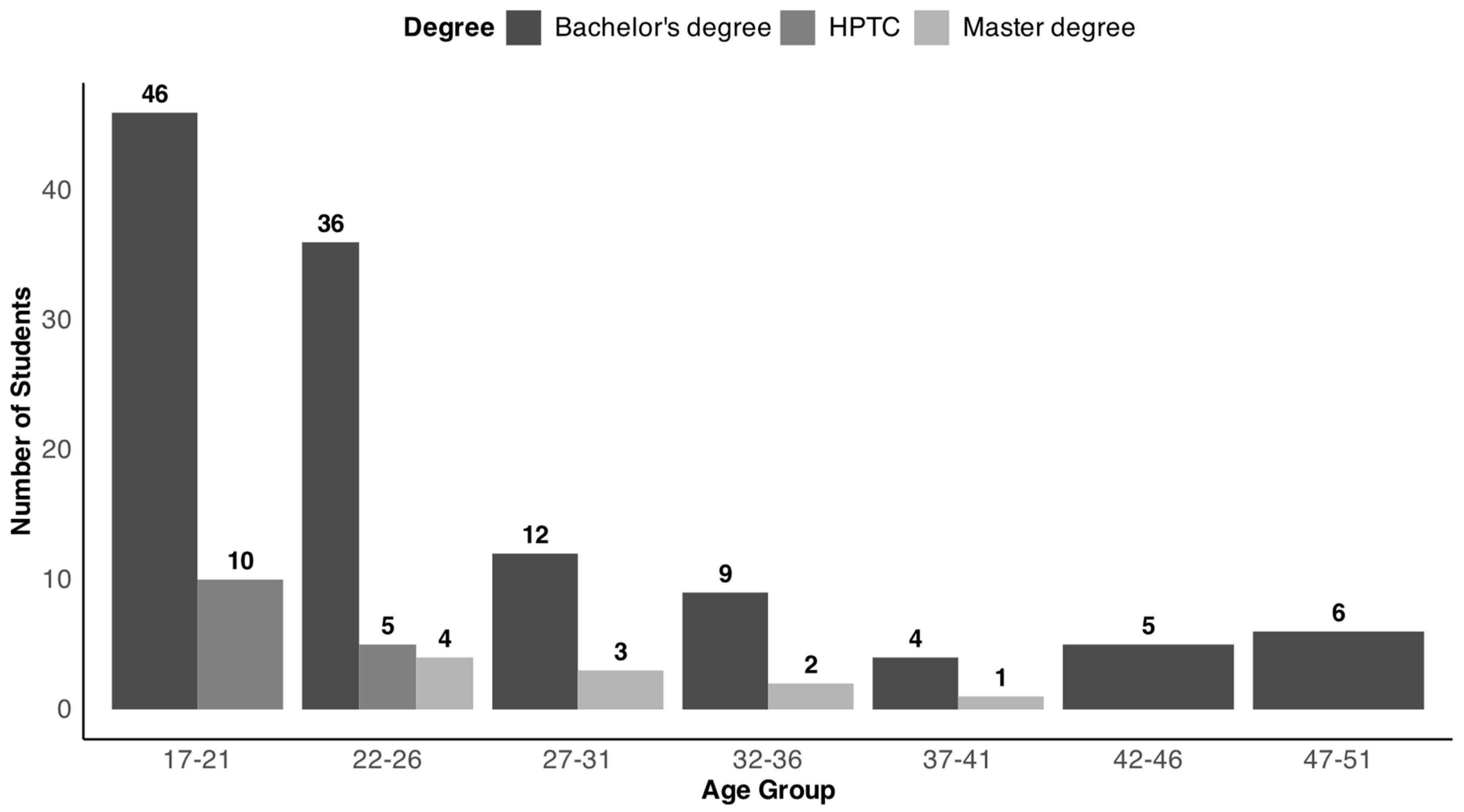Higher Education Students’ Biodiversity Knowledge
Abstract
1. Introduction
2. Materials and Methods
2.1. Study Area
2.2. Research Design
- (1)
- Research approach: Mixed-methods approach, combining quantitative and qualitative data to gain a comprehensive understanding of students’ biodiversity knowledge;
- (2)
- Study population: The target population included ISEC Lisboa students enrolled in 2023/2024;
- (3)
- Data collection methods: A structured survey was administered to assess biodiversity knowledge (quantitative data), and a course curriculum review (quantitative and qualitative data) was analyzed to determine the depth and scope of biodiversity education;
- (4)
- Data analysis: The data analysis incorporated descriptive and inferential statistics to examine the relationship between academic and biodiversity knowledge;
- (5)
- Expected outcomes: A clearer understanding of students’ biodiversity knowledge and insights into the impact of academic content on biodiversity awareness.
2.3. Data Collection and Statistical Analysis
- (1)
- Sociodemographic information;
- (2)
- Study year and course;
- (3)
- Biodiversity on the Lumiar campus;
- (4)
- Species’ conservation status;
- (5)
- Importance of biodiversity.
3. Results
3.1. Curricular Units
3.2. Descriptive Survey Results
3.2.1. Demographic Data
3.2.2. Perception of Biodiversity
3.2.3. Fauna and Flora Observation
3.2.4. Conservation Status of Flora and Fauna on Campus
3.2.5. Importance of Biodiversity
4. Discussion
5. Conclusions
Supplementary Materials
Author Contributions
Funding
Institutional Review Board Statement
Informed Consent Statement
Data Availability Statement
Acknowledgments
Conflicts of Interest
References
- Akinsemolu, A. A. (2018). The role of microorganisms in achieving the sustainable development goals. Journal of Cleaner Production, 182, 115239. [Google Scholar] [CrossRef]
- Arcila Hernández, L. M., Zamudio, K. R., Drake, A. G., & Smith, M. K. (2021). Implementing team-based learning in the life sciences: A case study in an online introductory level evolution and biodiversity course. Ecology and Evolution, 11(8), 3527–3536. [Google Scholar] [CrossRef]
- Ardoin, N. M., Bowers, A. W., & Gaillard, E. (2020). Environmental education outcomes for conservation: A systematic review. Biological Conservation, 241, 108224. [Google Scholar] [CrossRef]
- Bermudez, G. M. A., & Lindemann-Matthies, P. (2020). “What matters is species richness”—High school students’ understanding of the components of biodiversity. Research in Science Education, 50(6), 2159–2187. [Google Scholar] [CrossRef]
- Bogner, F. X. (1998). The Influence of short-term outdoor ecology education on long-term variables of environmental perspective. The Journal of Environmental Education, 29(4), 17–29. [Google Scholar] [CrossRef]
- Borges, F., & Benayas, J. (2019). Research in EE and ESD in Portuguese public universities. International Journal of Sustainability in Higher Education, 20(1), 57–74. [Google Scholar] [CrossRef]
- Børresen, S. T., Ulimboka, R., Nyahongo, J., Ranke, P. S., Skjaervø, G. R., & Røskaft, E. (2023). The role of education in biodiversity conservation: Can knowledge and understanding alter locals’ views and attitudes towards ecosystem services? Environmental Education Research, 29(1), 148–163. [Google Scholar] [CrossRef]
- Câmara, A., Proença, A., Teixeira, F., Freitas, H., Gil, H., Vieira, I., Pinto, J., Soares, L., Gomes, M., Gomes, M., Amaral, M., & Castro, S. (2018). Referencial de educação ambiental para a sustentabilidade. Available online: https://www.dge.mec.pt/sites/default/files/ECidadania/Educacao_Ambiental/documentos/referencial_ambiente.pdf (accessed on 9 February 2025).
- Christensen, A., Rowe, S., & Needham, M. D. (2007). Value orientations, awareness of consequences, and participation in a whale watching education program in Oregon. Human Dimensions of Wildlife, 12(4), 289–293. [Google Scholar] [CrossRef]
- Coracero, E. E., Facun, M. C. T., Gallego, R. J., Lingon, M. G., Lolong, K. M., Lugayan, M. M., Montesines, K. B. G., Sangalang, L. R., & Suniega, M. J. A. (2022). Knowledge and perspective of students towards biodiversity and its conservation and protection. Asian Journal of University Education, 18(1), 118–131. [Google Scholar] [CrossRef]
- Council of Ministers Resolution No. 100/2017. (2017). Gabinete do representante da república para a região autónoma dos açores decreto do representante da república para a região autónoma dos açores n.o 1/2017 de 11 de julho. Diário Da República, 1.a Série, N.o 132, de 11 de Julho de 2017. Available online: https://files.diariodarepublica.pt/1s/2017/07/13200/0353303550.pdf (accessed on 28 February 2025).
- Delector, R. T. (2023). Students’ knowledge and attitude towards biodiversity conservation. Asian Journal of Biodiversity, 14(1), 88–100. [Google Scholar] [CrossRef]
- Drissner, J., Haase, H.-M., & Hille, K. (2010). Short-term environmental education—Does it work?—An evaluation of the ‘Green Classroom’. Journal of Biological Education, 44(4), 149–155. [Google Scholar] [CrossRef]
- ENEA. (2025). National environmental education strategy website. Available online: https://enea.apambiente.pt/ (accessed on 28 February 2025).
- Eriksson, L., & Klapwijk, M. J. (2019). Attitudes towards biodiversity conservation and carbon substitution in forestry: A study of stakeholders in Sweden. Forestry, 92(2), 219–229. [Google Scholar] [CrossRef]
- Findler, F., Schönherr, N., Lozano, R., Reider, D., & Martinuzzi, A. (2019). The impacts of higher education institutions on sustainable development: A review and conceptualization. International Journal of Sustainability in Higher Education, 20(1), 23–38. [Google Scholar] [CrossRef]
- Franzolin, F., Carvalho, G. S., Santana, C. M. B., Calegari, A. D. S., de Almeida, E. A. E., Soares, J. P. R., Jorge, J., Das Neves, F. D., & Lemos, E. R. S. (2021). Students’ interests in biodiversity: Links with health and sustainability. Sustainability, 13(24), 13767. [Google Scholar] [CrossRef]
- Gabriel O., Y., David, E. D., & Mbakuuv, N. B. (2022). Awareness of wildlife conservation and ecotourism management among public secondary school students in Makurdi metropolis, Nigeria. International Journal of Environmental and Ecology Research, 4, 23–29. [Google Scholar]
- Hancock, L., & Hirsheimer, B. (2020). 68% average decline in species population sizes since 1970, says new WWF report. Available online: https://www.worldwildlife.org/press-releases/68-average-decline-in-species-population-sizes-since-1970-says-new-wwf-report (accessed on 9 February 2025).
- Ibrahim, M. S. N., Assim, M. I. S. A., Johari, S., Mohammad, S. K. W., Afandi, S. H. M., & Hassan, S. (2023). Public awareness on biodiversity conservation and well-being: Case of Gunung Mulu National Park, Sarawak. GeoJournal, 88(3), 3471–3496. [Google Scholar] [CrossRef]
- Id Babou, A., Selmaoui, S., Alami, A., Benjelloun, N., & Zaki, M. (2023). Teaching biodiversity: Towards a sustainable and engaged education. Education Sciences, 13(9), 931. [Google Scholar] [CrossRef]
- Ishibashi, S., Akasaka, M., Koyanagi, T. F., Yoshida, K. T., & Soga, M. (2020). Recognition of local flora and fauna by urban park users: Who notices which species? Urban Forestry and Urban Greening, 56, 126867. [Google Scholar] [CrossRef]
- Jensen, B. B. (2002). Knowledge, action and pro-environmental behaviour. Environmental Education Research, 8(3), 325–334. [Google Scholar] [CrossRef]
- João, P., Sá, P., Henriques, M. H., & Rodrigues, A. V. (2022). Sustainable development in basic education sciences in Portugal—Perspective of official curriculum documents. Sustainability, 14(9), 5651. [Google Scholar] [CrossRef]
- Kanosvamhira, T. (2025). Growing together: Unveiling the potential of school-based community gardens to foster well-being, empowerment, and sustainability. Urban Transformations, 7, 2. [Google Scholar] [CrossRef]
- Kleespies, M., Hahn-Klimroth, M., & Dierkes, P. (2024). Perceptions of biodiversity loss among future decision-makers in 37 countries. Npj Biodiversity, 3, 21. [Google Scholar] [CrossRef]
- Montgomery, L., Gange, A., Watling, D., & Harvey, D. (2022). Children’s perception of biodiversity in their school grounds and its influence on their wellbeing and resilience. Journal of Adventure Education and Outdoor Learning, 24, 187–201. [Google Scholar] [CrossRef]
- Mutisya, S. M., Kipgetich, K. E., & Rono, K. J. (2013). Asian journal of management sciences & education positive attitude towards environmental conservation: The role of primary education in Kenya. Asian Journal of Management Sciences & Education, 4(2), 203–215. [Google Scholar]
- Navarro-Perez, M., & Tidball, K. (2012). Challenges of biodiversity education: A review of education strategies for biodiversity education. International Electronic Journal of Environmental Education, 2(1), 13–30. [Google Scholar]
- Nolan, K. (2020). Biodiversity education and sustainability consciousness—A study on the effect of biodiversity education on the sustainability consciousness of Irish primary school students [Master’s thesis, Linköping University]. [Google Scholar]
- Oliveira, A. P., Bajanca, A., & Paramés, A. (2025). Unveiling urban biodiversity: An interdisciplinary hands-on project that catalyzes awareness. Environmental and Sustainability Indicators, 25, 100561. [Google Scholar] [CrossRef]
- Picanço, A., Arroz, A. M., Amorim, I. R., Matos, S., & Gabriel, R. (2021). Teachers’ perspectives and practices on biodiversity web portals as an opportunity to reconnect education with nature. Environmental Conservation, 48(1), 25–32. [Google Scholar] [CrossRef]
- Purvis, A., & Hector, A. (2000). Getting the measure of biodiversity. Nature, 405(6783), 212–219. [Google Scholar] [CrossRef]
- Schelhas, J., & Lassoie, J. P. (2001). Learning conservation and sustainable development: An interdisciplinary approach. Journal of Natural Resources and Life Sciences Education, 30(1), 111–119. [Google Scholar] [CrossRef]
- Schmidt, L., Nave, J. G., O’Riordan, T., & Guerra, J. (2011). Trends and dilemmas facing environmental education in Portugal: From environmental problem assessment to citizenship involvement. Journal of Environmental Policy and Planning, 13(2), 159–177. [Google Scholar] [CrossRef]
- Smith-Sebasto, N. J., & Cavern, L. (2006). Effects of pre-and posttrip activities associated with a residential environmental education experience on students’ attitudes toward the environment. Journal of Environmental Education, 37(4), 3–17. [Google Scholar] [CrossRef]
- Tiago, P., Leal, A., Rosário, I., & Chozas, S. (2024). Discovering urban nature: Citizen science and biodiversity on a university campus. Urban Ecosystems, 27, 1609–1621. [Google Scholar] [CrossRef]
- Trong Nguyen, L., & Tran, D. V. (2024). Biodiversity conservation perception among university students in Mekong Delta, Vietnam. Journal of Human Behavior in the Social Environment, 34(6), 839–854. [Google Scholar] [CrossRef]
- United Nations. (1992). United Nations. Convention on biological diversity. Available online: https://www.cbd.int/doc/legal/cbd-en.pdf (accessed on 9 February 2025).
- Vaverková, M. D., Polak, J., Kurcjusz, M., Jena, M. K., Murali, A. P., Nair, S. S., Aktaş, H., Hadinata, M. E., Ghezelayagh, P., Andik, S. D. S., Rahmana, A., & Franc-Dąbrowska, J. (2024). Enhancing sustainable development through interdisciplinary collaboration: Insights from diverse fields. In Sustainable development (pp. 1–28). John Wiley and Sons Ltd. [Google Scholar] [CrossRef]
- Wang, Z., Wang, T., Zhang, X., Wang, J., Yongsheng, Y., Sun, Y., Guo, X., Wu, Q., Nepovimova, E., Watson, A., & Kuca, K. (2024). Biodiversity conservation in the context of climate change: Facing challenges and management strategies. Science of the Total Environment, 937, 173377. [Google Scholar] [CrossRef]
- WWF. (2024). Living planet report 2024—A system in Peril. WWF. Available online: https://wwflpr.awsassets.panda.org/downloads/2024-living-planet-report-a-system-in-peril.pdf (accessed on 22 February 2025).
- Žalėnienė, I., & Pereira, P. (2021). Higher education for sustainability: A global perspective. Geography and Sustainability, 2(2), 99–106. [Google Scholar] [CrossRef]



| Design | Education | Renewable Energy | Engineering | Management | Health | p-Value | |
|---|---|---|---|---|---|---|---|
| Includes the diversity of relationships and processes established in ecosystems | 4 (10.3%) | 25 (13.4%) | 2 (5.7%) | 7 (11.5%) | 3 (9.1%) | 2 (28.6%) | 1.058 |
| Includes genetic diversity | 4 (10.3%) | 6 (3.2%) | 3 (8.6%) | 4 (6.6%) | 3 (9.1%) | 0 (0%) | 1.348 |
| Includes ecosystems | 7 (17.9%) | 23 (12.3%) | 1 (2.9%) | 6 (9.8%) | 5 (15.2%) | 0 (0%) | 1.519 |
| I don’t know what biodiversity is | 0 (0%) | 2 (1.1%) | 0 (0%) | 0 (0%) | 0 (0%) | 0 (0%) | 0.581 |
| Number of animals and plants | 2 (5.1%) | 8 (4.3%) | 1 (2.9%) | 4 (6.6%) | 0 (0%) | 0 (0%) | 1.169 |
| Number of fungi and microorganisms | 0 (0%) | 2 (1.1%) | 0 (0%) | 1 (1.6%) | 0 (0%) | 0 (0%) | 0.569 |
| Species richness of an ecosystem | 10 (25.6%) | 48 (25.7%) | 9 (25.7%) | 11 (18%) | 6 (18.2%) | 2 (28.6%) | 0.917 |
| Variation in organisms within the same species | 1 (2.6%) | 8 (4.3%) | 5 (14.3%) | 4 (6.6%) | 1 (3%) | 0 (0%) | 0.732 |
| Variety of living beings in a region | 4 (10.3%) | 30 (16%) | 7 (20%) | 12 (19.7%) | 5 (15.2%) | 1 (14.3%) | 0.935 |
| Variety of living beings that inhabit the planet | 7 (17.9%) | 35 (18.7%) | 7 (20%) | 12 (19.7%) | 10 (30.3%) | 2 (28.6%) | 0.441 |
| Design | Education | Renewable Energy | Engineering | Management | Health | p-Value | |
|---|---|---|---|---|---|---|---|
| Amphibians | 1 (4%) | 7 (5.6%) | 1 (4%) | 1 (2.6%) | 0 (0%) | 0 (0%) | 0.888 |
| Birds | 11 (44%) | 68 (54.4%) | 14 (56%) | 19 (48.7%) | 10 (52.6%) | 6 (75%) | 0.625 |
| Mammals | 12 (48%) | 33 (26.4%) | 8 (32%) | 16 (41%) | 9 (47.4%) | 1 (12.5%) | 1.246 |
| Fish | 0 (0%) | 1 (0.8%) | 0 (0%) | 0 (0%) | 0 (0%) | 0 (0%) | 0.402 |
| Reptiles | 1 (4%) | 16 (12.8%) | 2 (8%) | 3 (7.7%) | 0 (0%) | 1 (12.5%) | 1.347 |
| Design | Education | Renewable Energy | Engineering | Management | Health | p-Value | |
|---|---|---|---|---|---|---|---|
| Arachnids | 7 (33.3%) | 26 (26.5%) | 5 (23.8%) | 10 (34.5%) | 3 (15.8%) | 0 (0%) | 1.001 |
| Insects | 12 (57.1%) | 65 (66.3%) | 12 (57.1%) | 18 (62.1%) | 13 (68.4%) | 1 (100%) | 0.363 |
| Mollusks | 2 (9.5%) | 3 (3.1%) | 3 (14.3%) | 1 (3.4%) | 3 (15.8%) | 0 (0%) | 1.215 |
| None | 0 (0%) | 4 (4.1%) | 1 (4.8%) | 0 (0%) | 0 (0%) | 0 (0%) | 0.858 |
| Design | Education | Renewable Energy | Engineering | Management | Health | p-Value | |
|---|---|---|---|---|---|---|---|
| Shrubs | 9 (37.5%) | 40 (32.5%) | 9 (36%) | 14 (40%) | 3 (17.6%) | 3 (33.3%) | 1.128 |
| Cacti | 0 (0%) | 1 (0.8%) | 2 (8%) | 0 (0%) | 0 (0%) | 0 (0%) | 0.671 |
| Palm trees | 3 (12.5%) | 9 (7.3%) | 0 (0%) | 0 (0%) | 0 (0%) | 0 (0%) | 1.343 |
| Trees | 12 (50%) | 73 (59.3%) | 14 (56%) | 21 (60%) | 14 (82.4%) | 6 (66.7%) | 0.637 |
| Species Type | Yes (n/%) | No (n/%) | Don’t Know (n/%) | Examples of Identified Species |
|---|---|---|---|---|
| Native | 13 (9.0%) | 10 (7.0%) | 121 (84.0%) | Grass, Common sparrow, Pine tree, Pigeon, Plane tree |
| Invasive | 26 (17.0%) | 15 (10.0%) | 103 (67.8%) | Nettles, Climbing plants, Hydrangeas, Cats, Parakeets, Eucalyptus, Bees |
| Exotic | 18 (12.0%) | 18 (12.0%) | 108 (71.0%) | Parrots, Palm trees, Parakeet |
| Totally Agree | Agree | Neither Agree nor Disagree | Disagree | Totally Disagree | |
|---|---|---|---|---|---|
| Biodiversity loss is also a health issue, as the destruction of nature increases the risk of disease and reduces our resistance to it. | 38.9% (56) | 36.8% (53) | 17.4% (25) | 2.1% (3) | 4.9% (7) |
| The different species frequently present in urban areas perform various functions and generate ecological goods and services that are highly valued and appreciated. | 29.9% (43) | 42.4% (61) | 21.5% (31) | 3.5% (5) | 2.8% (4) |
| Tropical forests are one of the regions on planet Earth with the greatest diversity of fauna and flora. | 33.3% (48) | 35.4% (51) | 25.0% (36) | 3.5% (5) | 2.8% (4) |
| In urban areas, fauna is essential for pollination, biological pest control, and seed dispersal. | 27.8% (40) | 43.1% (62) | 23.6% (34) | 1.4% (2) | 4.2% (6) |
| Biodiversity loss is an intergenerational issue, as we are depriving future generations of the essentials for a fulfilling life. | 41.0% (59) | 34.0% (49) | 18.8% (27) | 2.1% (3) | 4.2% (6) |
| Biodiversity has been highlighted within urban areas for its contribution to improving citizens’ quality of life. | 31.2% (45) | 37.5% (54) | 22.2% (32) | 4.9% (7) | 4.2% (6) |
| Vegetation captures carbon, filters the air, and helps to mitigate the thermal island effect within urban areas. | 31.9% (46) | 37.5% (54) | 25.0% (36) | 1.4% (2) | 4.2% (6) |
| Green spaces and urban parks constitute important reservoirs of biodiversity within cities, enabling the permanence of a large number of native species, even in highly artificialized areas. | 32.6% (47) | 42.4% (61) | 20.1% (29) | 1.4% (2) | 3.5% (5) |
| The overexploitation of natural resources (such as overfishing and destructive agricultural practices), climate change, pollution, and invasive alien species are all adding to the problem of biodiversity loss. | 37.5% (54) | 34.0% (49) | 20.8% (30) | 3.5% (5) | 4.2% (6) |
| Around 1 million species are at risk of extinction within a few decades, mainly due to the conversion of natural habitats into agricultural land and the expansion of urban areas. | 27.8% (40) | 38.9% (56) | 28.5% (41) | 2.1% (3) | 2.8% (4) |
Disclaimer/Publisher’s Note: The statements, opinions and data contained in all publications are solely those of the individual author(s) and contributor(s) and not of MDPI and/or the editor(s). MDPI and/or the editor(s) disclaim responsibility for any injury to people or property resulting from any ideas, methods, instructions or products referred to in the content. |
© 2025 by the authors. Licensee MDPI, Basel, Switzerland. This article is an open access article distributed under the terms and conditions of the Creative Commons Attribution (CC BY) license (https://creativecommons.org/licenses/by/4.0/).
Share and Cite
Oliveira, A.P.; Paramés, A.; Bajanca, A.; Martinez-Perez, C. Higher Education Students’ Biodiversity Knowledge. Educ. Sci. 2025, 15, 499. https://doi.org/10.3390/educsci15040499
Oliveira AP, Paramés A, Bajanca A, Martinez-Perez C. Higher Education Students’ Biodiversity Knowledge. Education Sciences. 2025; 15(4):499. https://doi.org/10.3390/educsci15040499
Chicago/Turabian StyleOliveira, Ana Paula, Ana Paramés, António Bajanca, and Clara Martinez-Perez. 2025. "Higher Education Students’ Biodiversity Knowledge" Education Sciences 15, no. 4: 499. https://doi.org/10.3390/educsci15040499
APA StyleOliveira, A. P., Paramés, A., Bajanca, A., & Martinez-Perez, C. (2025). Higher Education Students’ Biodiversity Knowledge. Education Sciences, 15(4), 499. https://doi.org/10.3390/educsci15040499






